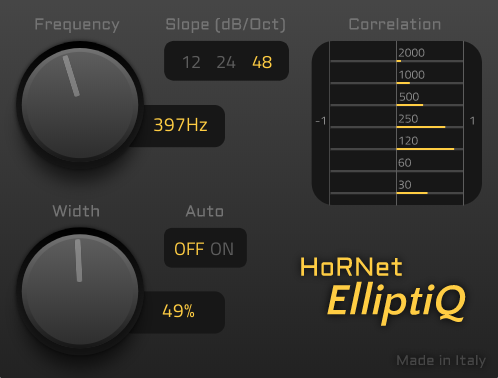HoRNet plugins up to 82% off with the code HP82FS for the next |
HoRNet ElliptiQ, the anti-phase fix EQ has been updated

We have just updated ElliptiQ, our anti-phase fix EQ.
HoRNet ElliptiQ is an advanced elliptical equalizer, a tool specifically designed to address a very particular problem in the audio production world, particularly when working with vinyl records. The inspiration for this tool comes from the golden age of vinyl cutting, a period when engineers had to be extremely cautious about how they manipulated low-frequency content, especially in the stereo channels. If the bass frequencies went out of phase, or if the difference between the left and right channels became too wide, the results could be disastrous. Specifically, the cutting needle used in vinyl mastering might jump out of the groove, ruining the final master.
To counter this issue, an elliptical EQ was introduced, targeting the phase relationship between the two stereo channels. The primary function of this EQ is to reduce the potential for phase issues in the low-end by adjusting the difference between the left and right channels, particularly in the bass range. This ensures that the bass remains solid and coherent, preventing problems when transferring the track to vinyl. Essentially, it removes certain low frequencies that might cause the needle to mistrack.
In today’s music production environment, vinyl is experiencing a renaissance, with many producers and engineers returning to the analog medium for its unique warmth and character. However, even in a digital world, the principles behind the elliptical EQ are still highly useful. For example, you can use this tool to reduce the stereo wideness of the bass in your tracks, fixing anti-phase issues where the left and right channels are not in sync with each other. In addition, it can be used creatively to make the bass sound mono, which is often desirable in modern mixdowns, where a focused, centered bass provides clarity and punch.
An elliptical EQ works by processing the side component of a stereo signal. To understand how this works, we need to look at the Mid/Side (M/S) matrix. This matrix encodes the stereo signal into two components: the mid (the sum of the left and right channels) and the side (the difference between the left and right channels). By working on the side component, the elliptical EQ can selectively reduce stereo width in the low-end frequencies, thus eliminating phase issues without affecting the mid part of the signal. This is crucial for preserving the integrity of the stereo image while ensuring that the bass remains solid and phase-coherent.
The process begins when the plugin encodes the stereo signal into the Mid/Side matrix, which separates the difference between the left and right channels. Once this is done, the plugin filters the side component of the signal using a low shelf filter, effectively removing certain frequencies from the side while leaving the mid section untouched. After this adjustment, the signal is reconstructed, producing a stereo output where the low frequencies have been narrowed, thus preventing the possibility of the bass becoming too wide and problematic.
One of the standout features of HoRNet ElliptiQ is its flexibility in handling the low-end frequencies. The plugin allows you to filter out frequencies up to 2000Hz, extending all the way into the mid-range frequencies. This wide range of adjustment gives you control over how much of the stereo width you want to cut, providing a powerful tool for tackling a variety of mix problems related to phase issues and low-end clarity.
To achieve this, the plugin uses a Butterworth-style low shelf filter, with three selectable slopes: 12 dB/octave, 24 dB/octave, and 48 dB/octave. These slopes offer a range of options, from a gentle, smooth curve to a very steep cut, allowing you to dial in just the right amount of reduction in stereo width. This flexibility makes ElliptiQ adaptable to various types of tracks, from those that require subtle adjustments to more extreme cases where a sharp, dramatic change is needed.
In addition to these technical features, ElliptiQ includes an auto width function that is especially helpful for producers working with complex mixes. When activated, the auto width function continuously evaluates the difference between the mid and side components of the signal. If the plugin detects that the side information is too high, indicating that the stereo width of the bass is excessively wide, it automatically reduces the stereo width. This ensures that the bass frequencies remain in-phase, preventing any potential phase cancellation and enhancing the track’s overall impact and presence.
The correlation meter in ElliptiQ is another valuable tool for detecting and addressing phase issues. Divided into seven key frequencies, the correlation meter provides a visual representation of how much phase difference exists at different points in the frequency spectrum. This allows you to quickly spot any problematic areas in the low-end, making it easier to correct anti-phase issues and ensuring that your track will sound solid and coherent on any playback system.
The latest version of HoRNet ElliptiQ—version 1.0.2—is a maintenance update that brings several important improvements. One of the key fixes addresses a potential crash issue in both Studio One and Cubase on macOS when removing the plugin from a track. This update ensures a smoother and more stable user experience. Additionally, the width knob scaling has been improved, making it easier to dial in the precise amount of stereo width reduction. These enhancements improve both the functionality and usability of the plugin, making it an even more powerful tool for producers and engineers.
This update is available for free to all owners of the plugin, and it can be downloaded directly from the user area.